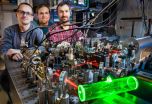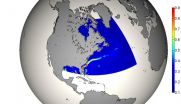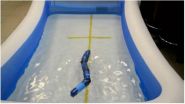(Press-News.org) A Brigham and Women's Hospital-led team has identified a long sought-after partner for a key immune protein, called TIM-3, that helps explain its two-faced role in the immune system -- sometimes dampening it, other times stimulating it. This newly identified partner not only sheds light on the inner workings of the immune system in diseases such as HIV, autoimmunity, and cancer, but also provides a critical path toward the development of novel treatments that target TIM-3. The researcher's findings appeared last month in the journal Nature.
"There has been a lot of confusion around TIM-3 -- how does it both inhibit and activate the immune system," said Richard Blumberg, chief of the Division of Gastroenterology, Hepatology and Endoscopy at Brigham and Women's Hospital (BWH) and senior author of the paper. "This is a crucial question because TIM-3 has been recognized as an important drug target, but nobody really understands exactly how to approach it because of this Janus-like property."
The interest in TIM-3 as a drug target stems largely from its inhibitory role, particularly in cancer. When immune cells are stimulated over long periods of time, they switch on signals, such as TIM-3, that help them dial down their own activity. This chronically activated state, termed "exhaustion," is an immunological hallmark of chronic viral infections, such as HIV. It is also common in cancer. If there were a way to block TIM-3 pharmacologically, it could unleash the immune system, freeing it to attack tumors.
Despite this interest, the details of how TIM-3 works have been unclear -- until now. Blumberg, Vijay Kuchroo, PhD, director, Evergrande Center for Immunologic Diseases at Harvard Medical School and BWH, and colleagues, led by first author Yu-Hwa Huang, identified a critical TIM-3 partner, called CEACAM-1, whose presence determines how TIM-3 will behave. In CEACAM-1's presence, TIM-3 acts as an inhibitor. In its absence, TIM-3 takes on the properties of an activator.
These two molecules work together, forming a completely new structure that had never been appreciated before. In addition to their close partnership, they are highly similar to each other, on both structural and functional levels. In fact, it is these similarities that first led Huang to propose CEACAM-1 as TIM-3's long sought after partner.
Using a variety of approaches, Blumberg and his team were able to reveal the essence of CEACAM-1's role. Importantly, immune cells engineered to lack CEACAM-1 show increased inflammation. In mouse models of colorectal cancer, simultaneous blockade of both CEACAM-1 and TIM-3 led to enhanced anti-tumor responses.
"What's so exciting is that our data tell us how to target TIM-3," said Blumberg. "This really points us along a path to develop a completely new treatment paradigm for cancer as well as for other diseases, such as HIV."
INFORMATION:
This research was funded by the National Institutes of Health (NIH DK51362), the Harvard Digestive Diseases Center and by a Research Fellowship Award from the Crohn's and Colitis Foundation of America to Yu-Hwa Huang.
Brigham and Women's Hospital (BWH) is a 793-bed nonprofit teaching affiliate of Harvard Medical School and a founding member of Partners HealthCare. BWH has more than 3.5 million annual patient visits, is the largest birthing center in Massachusetts and employs nearly 15,000 people. The Brigham's medical preeminence dates back to 1832, and today that rich history in clinical care is coupled with its national leadership in patient care, quality improvement and patient safety initiatives, and its dedication to research, innovation, community engagement and educating and training the next generation of health care professionals. Through investigation and discovery conducted at its Brigham Research Institute (BRI), BWH is an international leader in basic, clinical and translational research on human diseases, more than 1,000 physician-investigators and renowned biomedical scientists and faculty supported by nearly $650 million in funding. For the last 25 years, BWH ranked second in research funding from the National Institutes of Health (NIH) among independent hospitals. BWH continually pushes the boundaries of medicine, including building on its legacy in transplantation by performing a partial face transplant in 2009 and the nation's first full face transplant in 2011. BWH is also home to major landmark epidemiologic population studies, including the Nurses' and Physicians' Health Studies and the Women's Health Initiative. For more information, resources and to follow us on social media, please visit BWH's online newsroom.
Conservationists are always looking for ways to halt the pace of deforestation in tropical rainforests. One approach involves recultivating abandoned agricultural land. An international team* investigating this concept has just published its findings in Nature Communications. Working in the mountainous regions of Ecuador, the researchers found afforestation and intense pasturing to be particularly effective, clearly increasing the environmental and economic value of abandoned farmlands.
Every year, 130,000 square kilometers of rainforest disappear from the face of the ...
This news release is available in German.
A drunken sailor staggers onto a square with lots of streetlamps on it. Sometimes he will run into one of the lamps, change his direction and keep moving. Does the time he spends on this square depend on the number of streetlamps? The surprising answer is: no.
No matter whether there is a streetlamp on every square meter or whether the distance between the lamps is large: on average, the drunken sailor will always spend the same amount of time on the square. Calculations at the Vienna University of Technology (TU Wien) ...
Neither quantum computers nor quantum cryptography will become prevalent technologies without memory systems able to manipulate quantum information easily and effectively. The Faculty of Physics at the University of Warsaw has recently made inroads into popularizing quantum information technologies by creating an atomic memory with outstanding parameters and an extremely simple construction.
Following years of tests in physics laboratories, the first quantum technologies are slowly emerging into wider applications. One example is quantum cryptography - an encryption ...
The ocean is undergoing global changes at a remarkable pace and we must change with it to attain our best possible future ocean, warns the head of The University of Western Australia's Oceans Institute.
One of the global leaders in ocean science, Professor Carlos Duarte has shared his insights on the future of the world's oceans in a paper published in the international open-access journal Frontiers in Marine Science.
In the paper Professor Duarte explains the grand challenge researchers face in addressing global change and the future state of the ocean.
"The ocean ...
This news release is available in German. Just four months after the final data package from the GOCE satellite mission was delivered, researchers are laying out a rich harvest of scientific results, with the promise of more to come. A mission of the European Space Agency (ESA), the Gravity Field and Steady-State Ocean Circulation Explorer (GOCE) provided the most accurate measurements yet of Earth's gravitational field. The GOCE Gravity Consortium, coordinated by the Technische Universität München (TUM), produced all of the mission's data products including ...
The value of a piece of chocolate cake can change. Someone who happens to be on a diet is more likely to choose a fruit dessert and judge the calorie-laden cake as unhealthy. Previous studies have shown that a specific network in the brain is active when a person must decide between various choices that vary depending on context. They emphasize the interaction between neurons in two brain areas of the prefrontal cortex - the controlling area on the front side of the brain.
Prefrontal cortex shows increased activity in all decisions
Sarah Rudorf and Todd Hare of the ...
On 24 October 2014, Sweden called off the hunt for a submarine after a week-long underwater search in the Stockholm archipelago. Triggered by a reported sighting of a Russian submarine, the alleged 'invasion' had been widely anticipated by military specialists and the media.
"Our assessment is that in the inner archipelago there was a plausible foreign underwater operation," Rear Adm. Anders Grenstad commented, "But we believe that what has violated Swedish waters has left."
"Whatever was there could not have been a conventional submarine," Grenstad said, but a "craft ...
This news release is available in Japanese.
The deep ocean seems so remote that it is difficult to imagine any sort of human-generated change making an impact on deep-sea life. It is even more difficult to collect or examine evidence from the deep ocean to determine what those impacts might be. Enter the barnacle; a hard, sessile creature that looks like a tiny volcano and attaches to rocks, boat bottoms, and other hard substrates, where it filters ocean water to feed on tiny organisms. The barnacle holds clues about how climate change is affecting the deep ocean. ...
KNOXVILLE - Warfare not only hastened human technological progress and vast social and political changes, but may have greatly contributed to the evolutionary emergence of humans' high intelligence and ability to work together toward common goals, according to a new study from the National Institute for Mathematical and Biological Synthesis (NIMBioS).
How humans evolved high intelligence, required for complex collaborative activities, despite the various costs of having a big brain has long puzzled evolutionary biologists. While the human brain represents only about two ...
Published in the journal Nature, the discovery could revolutionise fuel cells and other hydrogen-based technologies as they require a barrier that only allow protons - hydrogen atoms stripped off their electrons - to pass through.
In addition, graphene membranes could be used to sieve hydrogen gas out of the atmosphere, where it is present in minute quantities, creating the possibility of electric generators powered by air.
One-atom thick material graphene, first isolated and explored in 2004 by a team at The University of Manchester, is renowned for its barrier properties, ...





